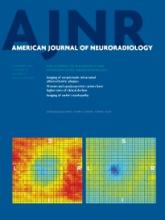Index by author
Bagci, A.M.
- Head & NeckOpen AccessAutomated Quantitation of the Posterior Scleral Flattening and Optic Nerve Protrusion by MRI in Idiopathic Intracranial HypertensionN. Alperin, A.M. Bagci, B.L. Lam and E. SklarAmerican Journal of Neuroradiology December 2013, 34 (12) 2354-2359; DOI: https://doi.org/10.3174/ajnr.A3600
Baker, B.J.
- SpineYou have accessSurfer's Myelopathy: A Radiologic Study of 23 CasesB.K. Nakamoto, A.M. Siu, K.A. Hashiba, B.T. Sinclair, B.J. Baker, M.S. Gerber, A.M. McMurtray, A.M. Pearce and J.W. PearceAmerican Journal of Neuroradiology December 2013, 34 (12) 2393-2398; DOI: https://doi.org/10.3174/ajnr.A3599
Banwell, B.
- EDITOR'S CHOICEPediatricsYou have accessNo Evidence for Impairment of Venous Hemodynamics in Children or Young Adults with Pediatric-Onset Multiple SclerosisS. Laughlin, C.K. Macgowan, J. Traubici, K. Chan, S. Khan, D.L. Arnold, R.A. Marrie and B. BanwellAmerican Journal of Neuroradiology December 2013, 34 (12) 2366-2372; DOI: https://doi.org/10.3174/ajnr.A3661
The results of venous sonography, contrast-enhanced MRI, and MR venography in 26 pediatric patients with MS were compared with controls and 13 young adults with pediatric-onset MS. The authors concluded that chronic cerebrospinal venous insufficiency is rarely observed in children or young adults with pediatric-onset MS as venous anatomy and flow rates showed normal outflow in most subjects.
Bartleson, J.D.
- FELLOWS' JOURNAL CLUBBrainYou have accessStroke-Like Migraine Attacks after Radiation Therapy (SMART) Syndrome Is Not Always Completely Reversible: A Case SeriesD.F. Black, J.M. Morris, E.P. Lindell, K.N. Krecke, G.A. Worrell, J.D. Bartleson and D.H. LachanceAmerican Journal of Neuroradiology December 2013, 34 (12) 2298-2303; DOI: https://doi.org/10.3174/ajnr.A3602
Clinical and imaging findings in 11 patients with SMART syndrome were reviewed. All patients became symptomatic on average 20 years postirradiation and all showed unilateral gyriform cerebral enhancement that resolved spontaneously in 2–5 weeks though 45% had residual neurologic deficits. Twenty-seven percent of patients developed laminar necrosis and brain biopsies of 4 patients showed nonspecific findings.
Bayer-karpinska, A.
- Extracranial VascularYou have accessCTA for Screening of Complicated Atherosclerotic Carotid Plaque—American Heart Association Type VI Lesions as Defined by MRIM. Trelles, K.M. Eberhardt, M. Buchholz, A. Schindler, A. Bayer-Karpinska, M. Dichgans, M.F. Reiser, K. Nikolaou and T. SaamAmerican Journal of Neuroradiology December 2013, 34 (12) 2331-2337; DOI: https://doi.org/10.3174/ajnr.A3607
Beall, E.B.
- FunctionalOpen AccessSex Differences in Resting-State Functional Connectivity in Multiple SclerosisK.A. Koenig, M.J. Lowe, J. Lin, K.E. Sakaie, L. Stone, R.A. Bermel, E.B. Beall, S.M. Rao, B.D. Trapp and M.D. PhillipsAmerican Journal of Neuroradiology December 2013, 34 (12) 2304-2311; DOI: https://doi.org/10.3174/ajnr.A3630
Bellile, E.L.
- Head & NeckOpen AccessCT Perfusion Can Predict Overexpression of CXCL8 (Interleukin-8) in Head and Neck Squamous Cell CarcinomaS.Y. Jo, P.I. Wang, J.E. Nör, E.L. Bellile, Z. Zhang, F.P. Worden, A. Srinivasan and S.K. MukherjiAmerican Journal of Neuroradiology December 2013, 34 (12) 2338-2342; DOI: https://doi.org/10.3174/ajnr.A3610
Bermel, R.A.
- FunctionalOpen AccessSex Differences in Resting-State Functional Connectivity in Multiple SclerosisK.A. Koenig, M.J. Lowe, J. Lin, K.E. Sakaie, L. Stone, R.A. Bermel, E.B. Beall, S.M. Rao, B.D. Trapp and M.D. PhillipsAmerican Journal of Neuroradiology December 2013, 34 (12) 2304-2311; DOI: https://doi.org/10.3174/ajnr.A3630
Bernstein, R.A.
- EDITOR'S CHOICEBrainOpen AccessT1 Gadolinium Enhancement of Intracranial Atherosclerotic Plaques Associated with Symptomatic Ischemic PresentationsP. Vakil, J. Vranic, M.C. Hurley, R.A. Bernstein, A.W. Korutz, A. Habib, A. Shaibani, F.H. Dehkordi, T.J. Carroll and S.A. AnsariAmerican Journal of Neuroradiology December 2013, 34 (12) 2252-2258; DOI: https://doi.org/10.3174/ajnr.A3606
The degree of contrast enhancement was assessed in 22 high-grade intracranial stenoses that were either symptomatic or asymptomatic. Seventy percent of symptomatic plaques showed contrast enhancement whereas this was seen in only 8% of those that were asymptomatic. This study suggests that intracranial stenoses can be evaluated with conventional MRI protocols and that there is a strong association between plaque contrast enhancement and ischemic symptoms.
Black, D.F.
- FELLOWS' JOURNAL CLUBBrainYou have accessStroke-Like Migraine Attacks after Radiation Therapy (SMART) Syndrome Is Not Always Completely Reversible: A Case SeriesD.F. Black, J.M. Morris, E.P. Lindell, K.N. Krecke, G.A. Worrell, J.D. Bartleson and D.H. LachanceAmerican Journal of Neuroradiology December 2013, 34 (12) 2298-2303; DOI: https://doi.org/10.3174/ajnr.A3602
Clinical and imaging findings in 11 patients with SMART syndrome were reviewed. All patients became symptomatic on average 20 years postirradiation and all showed unilateral gyriform cerebral enhancement that resolved spontaneously in 2–5 weeks though 45% had residual neurologic deficits. Twenty-seven percent of patients developed laminar necrosis and brain biopsies of 4 patients showed nonspecific findings.








